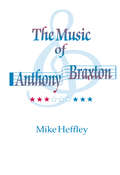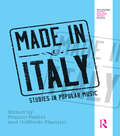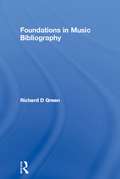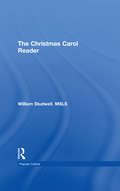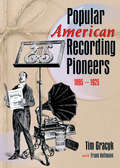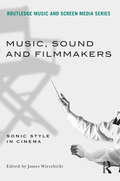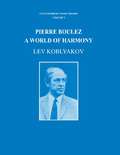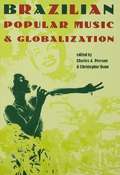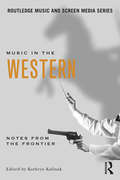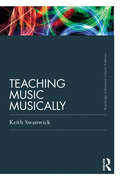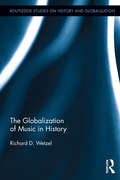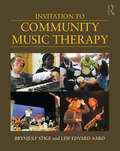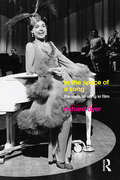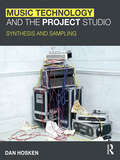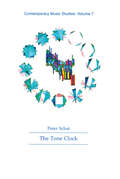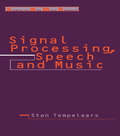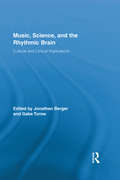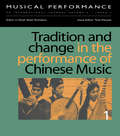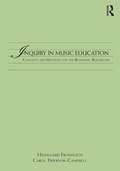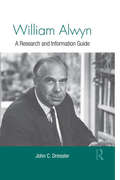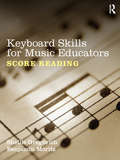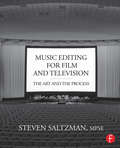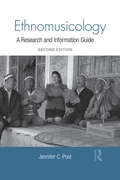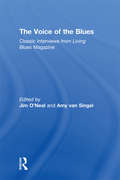- Table View
- List View
Music of Anthony Braxton (Contributions To The Study Of Music And Dance Ser. #No. 43)
by HeffleyFirst Published in 2001. Routledge is an imprint of Taylor & Francis, an informa company.
Made in Italy: Studies in Popular Music (Routledge Global Popular Music Series)
by Franco Fabbri Goffredo PlastinoMade in Italy serves as a comprehensive and rigorous introduction to the history, sociology, and musicology of contemporary Italian popular music. Each essay, written by a leading scholar of Italian music, covers the major figures, styles, and social contexts of pop music in Italy and provides adequate context so readers understand why the figure or genre under discussion is of lasting significance to Italian popular music. The book first presents a general description of the history and background of popular music, followed by essays organized into thematic sections: Themes; Singer-Songwriters; and Stories.
Foundations in Music Bibliography
by Richard D GreenAs more and more music literature is published each year, librarians, scholars, and bibliographers are turning to music bibliography to retain control over the flood of information. Based on the Conference of Music Bibliography, this timely book provides vital information on the most important aspects of the scholarly practice of music bibliography. Foundations in Music Bibliography provides librarians with great insight into bibliographic issues they face every day including bibliographic control of primary and secondary sources, the emergence of enumerative and analytical bibliography, bibliographic instruction, and bibliographic lacunae.Foundations in Music Bibliography features the perspectives of prominent scholars and music librarians on contemporary issues in music bibliography often encountered by music librarians. It offers practical insights and includes chapters on teaching students how to use microcomputer programs to search music bibliographies, organizing a graduate course in music bibliography, and researching film music bibliography. The book also provides a supplement to Steven D. Westcott’s A Comprehensive Bibliography of Music for Film and Television. This insightful volume demonstrates the many ways that bibliography relates music publications to each other and endows grander meaning to individual scholarly observations. Some of the fascinating topics covered by Foundations in Music Bibliography include: the history of thematic catalogs indexing Gregorian chant manuscripts general principles of bibliographic instruction analyses of Debussy discographies musical ephemera and their importance in various types of musicological research bibliographical lacunae (i.e. lack of access to visual sources, failure to control primary sources, and lack of communication with the rest of the performing arts)Foundations in Music Bibliography shows librarians how bibliography can be used to help music students and researchers find the information they need among the innumerable available sources. It is an indispensable asset to the shelves of all music reference libraries that wish to provide their patrons with the latest bibliographic tools.
The Christmas Carol Reader
by Frank Hoffmann William E Studwell B Lee CooperLike that Biblical, astronomical star of Bethlehem, The Christmas Carol Reader guides readers on their quest for information about Christmas songs. Studwell gathers a composite picture of the world's most important and famous carols and includes an ample selection of lesser-known Christmas songs. All of the carols are presented in their historical and cultural contexts which adds to readers’understanding and appreciation of the songs.As the only book that covers this elusive topic, The Christmas Carol Reader informs and entertains readers on over 200 songs of all types (sacred and secular), of all periods (Middle Ages through the 20th century), and from a number of countries and cultures. Because many of the songs in The Christmas Carol Reader fit into more than one distinct category, Studwell wisely divides the songs into two major groups--those that reflect Christmas as a Holy Day and those that celebrate Christmas as a Holiday. Here is just a sample of the breadth of coverage of songs:Sacred: From Heaven Above to Earth I Come; O Come, O Come Emmanuel; Angels From the Realms of Glory; As With Gladness Men of Old; O Holy Night (Cantique de Noël); Thou Didst Leave Thy ThroneSecular: Happy Holiday; A Holly Jolly Christmas; God Rest You Merry, Gentlemen; Silver Bells; Here Comes Santa Claus; I'll Be Home for ChristmasMedieval: Puer Natus in Bethlehem (A Boy Is Born in Bethlehem); Coventry Carol; I Sing of a Maiden; La marche des rois (The March of the Kings); In Dulci Jubilo1500--1700's: Bring a Torch, Jeanette, Isabella; I Saw Three Ships; Carol of the Bagpipers1800's: Adeste Fideles (O Come All Ye Faithful); O Little Town of Bethlehem; What Child Is This?; It Came Upon a Midnight Clear; Stille Nacht, Heiliege Nacht (Silent Night)Spirituals: Go Tell It on the Mountain; I Wonder as I Wander; Mary Had a Baby; Rise Up, Shepherd, and FollowLittle Known: O Bethlehem!; The Sleep of the Infant Jesus; Song of the Nuns of ChesterCountries and Cultures: O Tannenbaum; Lulajze Jezuniu (Polish Lullaby); Fum, Fum, Fum; Carol of the Bells; Patapan; El rorro (The Babe)As readers learn about the history and nature of the Christmas carol in general and the specific history of individual religious and secular carols, they will learn some history and nature of the holiday season which can bring more enjoyment into their celebrations for years to come.On long winter nights, The Christmas Carol Reader can be read continuously as a series of fact-based commentaries on Christmas music. For shorter periods in between holiday activities, readers can peruse one of the topical sections or select, with the aid of the title index, an individual essay of interest. As a library reference, this book can provide facts for research on Christmas songs or just provide an entertaining education for curious library patrons.
Popular American Recording Pioneers: 1895-1925
by Frank Hoffmann B Lee Cooper Tim GracykEncounter the trailblazers whose recordings expanded the boundaries of technology and brought “popular” music into America's living rooms!Popular American Recording Pioneers: 1895--1925 (winner of the 2001 Association for Recorded Sound Collections Award of Excellence in Historical Recorded Sound Research) covers the lives and careers of over one hundred musical artists who were especially important to the recording industry in its early years. Here are the men and women who brought into American homes the hits of the day--Tin Pan Alley numbers, Broadway show tunes, ragtime, parlor ballads, early jazz, and dance music of all kinds.Popular American Recording Pioneers: 1895--1925 compiles rare information that was scattered in hundreds of record catalogs, hobbyist magazines, newspaper clippings, phonograph trade journals, and other sources. Look no further! This volume is the ultimate resource on the subject!You will increase your knowledge in these areas: the recording industry's formative years artists’personalities and musical styles popular music history history of recording technologyPopular American Recording Pioneers: 1895--1925 provides a unique “who's who” approach to popular music history. It is the definitive work on the music that was popular during America's coming of age. No music historian should be without this volume.
Music, Sound and Filmmakers: Sonic Style in Cinema
by James WierzbickiMusic, Sound and Filmmakers: Sonic Style in Cinema is a collection of essays that examine the work of filmmakers whose concern is not just for the eye, but also for the ear. The bulk of the text focuses on the work of directors Wes Anderson, Ingmar Bergman, the Coen brothers, Peter Greenaway, Krzysztof Kieślowski, Stanley Kubrick, David Lynch, Quentin Tarantino, Andrey Tarkovsky and Gus Van Sant. Significantly, the anthology includes a discussion of films administratively controlled by such famously sound-conscious producers as David O. Selznick and Val Lewton. Written by the leading film music scholars from Europe, North America, and Australia, Music, Sound and Filmmakers: Sonic Style in Cinema will complement other volumes in Film Music coursework, or stand on its own among a body of research.
Pierre Boulez: A World of Harmony (Contemporary Music Studies #2)
by Lev KoblyakovFirst published in 1994. Routledge is an imprint of Taylor & Francis, an informa company.
Brazilian Popular Music and Globalization
by Charles A. Perrone Christopher DunnThis collection of articles by leading scholars traces the history of Brazilian pop music through the twentieth-century.
Music in the Western: Notes From the Frontier
by Kathryn KalinakMusic in the Western: Notes from the Frontier presents essays from both film studies scholars and musicologists on core issues in western film scores: their history, their generic conventions, their operation as part of a narrative system, their functioning within individual filmic texts and their ideological import, especially in terms of the western’s construction of gender, sexuality, race and ethnicity. The Hollywood western is marked as uniquely American by its geographic setting, prototypical male protagonist and core American values. Music in the Western examines these conventions and the scores that have shaped them. But the western also had a resounding international impact, from Europe to Asia, and this volume distinguishes itself by its careful consideration of music in non-Hollywood westerns, such as Ravenous and The Good, the Bad, and the Ugly and in the “easterns” which influenced them, such as Yojimbo. Other films discussed include Wagon Master, High Noon, Calamity Jane, The Big Country, The Unforgiven, Dead Man, Wild Bill, There Will Be Blood and No Country for Old Men. Contributors Ross CareCorey K. CreekmurYuna de LannoyK. J. DonnellyCaryl FlinnClaudia GorbmanKathryn KalinakCharles LeinbergerMatthew McDonaldPeter StanfieldMariana WhitmerBen Winters The Routledge Music and Screen Media Series offers edited collections of original essays on music in particular genres of cinema, television, video games and new media. These edited essay collections are written for an interdisciplinary audience of students and scholars of music and film and media studies.
Teaching Music Musically (Classic Edition)
by Keith Swanwick'There are countless gems within these pages ... Swanwick seems to write from more experience as a musician and teacher than most others who write for this audience. There is a real sense of his having been there. - Patricia Shehan Campbell, Professor of Music, University of Washington, USA'... contains the essential and highly valued hallmark of
The Globalization of Music in History (Routledge Studies on History and Globalization)
by Richard WetzelThis book contextualizes a globalization process that has since ancient times involved the creation, use, and world-wide movement of song, instrumental music, musical drama, music with dance, concert, secular, popular and religious music. Integral to the process have been political, economic, military, and religious forces that motivated or compelled performers to travel, often far beyond the borders of their homelands, to practice their art and craft. That this music was often a traveling companion to non-musical movements—military campaigns, religious missions, political events –does not make the distance it traveled, nor its cultural and social impact, less remarkable. The Globalization of Music in History contributes to a growing awareness of the power of music to give insight into those things that all cultures and civilizations hold in common, and that promote and nurture mankind’s most noble virtues. The book adds a philosophical perspective to ongoing work in ethnomusicology, musicology, music therapy, and what may be an evolving global music. It attributes this evolution to the motivation by musicians to travel and to spread music around the globe, and even into outer space. It also provides connectivity between the people, activities and events in which music is used and the means by which it moves from one place to another.
Invitation to Community Music Therapy
by Brynjulf Stige Leif Edvard AarøInvitation to Community Music Therapy presents the main perspectives and principles of community music therapy as it is practiced around the world. A relatively recent development within the broader field of music therapy, community music therapy emphasizes human connectedness, health promotion, and social change. This textbook surveys the history, theory, and current practice of community music therapy to develop a comprehensive picture of the field. Along the way it takes full measure of the diverse and vibrant ways community music therapy is practiced around the globe. Including dozens of photographs and pedagogical tools such as chapter questions, textboxes, figures, key terms, and discussion topics, Invitation to Community Music Therapy is the ideal introduction to a growing area of music therapy.
In The Space Of A Song: The Uses of Song in Film
by Richard DyerSongs take up space and time in films. Richard Dyer's In the Space of a Song takes off from this perception, arguing that the way songs take up space indicates a great deal about the songs themselves, the nature of the feelings they present, and who is allowed to present feelings how, when and where. In the Space of a Song explores this perception through a range of examples, from classic MGM musicals to blaxploitation cinema, with the career of Lena Horne providing a turning point in the cultural dynamics of the feeling. Chapters include: The perfection of Meet Me in St. Louis A Star Is Born and the construction of authenticity ‘I seem to find the happiness I seek’: Heterosexuality and dance in the musical The space of happiness in the musical Singing prettily: Lena Horne in Hollywood Is Car Wash a musical? Music and presence in blaxploitation cinema In the Space of a Song is ideal for both scholars and students of film studies.
Music Technology and the Project Studio: Synthesis and Sampling
by Dan HoskenMusic Technology and the Project Studio: Synthesis and Sampling provides clear explanations of synthesis and sampling techniques and how to use them effectively and creatively. Starting with analog-style synthesis as a basic model, this textbook explores in detail how messages from a MIDI controller or sequencer are used to control elements of a synthesizer to create rich, dynamic sound. Since samplers and sample players are also common in today's software, the book explores the details of sampling and the control of sampled instruments with MIDI messages. This book is not limited to any specific software and is general enough to apply to many different software instruments. Overviews of sound and digital audio provide students with a set of common concepts used throughout the text, and "Technically Speaking" sidebars offer detailed explanations of advanced technical concepts, preparing students for future studies in sound synthesis. Music Technology and the Project Studio: Synthesis and Sampling is an ideal follow-up to the author's An Introduction to Music Technology, although each book can be used independently. The Companion Website includes: Audio examples demonstrating synthesis and sampling techniques Interactive software that allows the reader to experiment with various synthesis techniques Guides relating the material in the book to various software synthesizers and samplers Links to relevant resources, examples, and software
Tone Clock (Contemporary Music Studies)
by Peter SchatIn addition, The Tone Clock contains a broad selection of Peter Schat's polemical writings, embracing historical, political, aesthetic and environmental perspectives. His book is not just of interest to composers, but it also provides a valuable insight for anyone interested in the development of twentieth-century music.Peter Schat, a former pupil of Pierre Boulez, exposes more than a new theory of music in The Tone Clock. Although he is a long-experienced serialist composer, in devising and using his tone clock system he has reached the clarity and simplicity which comprise two of his major compositional aims. His book, profusely illustrated with clearly analysed musical examples, will enable other composers to achieve similar aims in their own way, while remaining faithful to their own musical personalities.A former pupil of Pierre Boulez, Peter Schat is a well-known Dutch contemporary serialist composer.
Signal Processing, Speech and Music (Studies On New Music Research Ser. #Vol. 1)
by Stan TempelaarsFirst Published in 1996. Routledge is an imprint of Taylor & Francis, an informa company.
Musical Imagery
by Harald Jørgensen Rolf Inge Godøy, Rolf IngeAn edited collection of papers which explore a large number of topics related to musical imagery. Musical imagery can be defined as our mental capacity for imagining sound in the absence of a directly-audible sound source, meaning that we can recall and re-experience or even invent new musical sound through our inner ear. The first part of the volume is focused on theoretical issues such as the history, epistemology, neurological bases, and cognitive models of musical imagery. The second part presents various applications of musical imagery in performance and composition, and provides the reader with a broad overview of the many musical activities which are concerned with musical imagery.;Musical imagery is a truly interdisciplinary subject, and it is the belief of the editors that a plurality of approaches, ranging from the introspective and philosophical to the experimental and computational, is the most fruitful strategy for exploring the subject of musical imagery.
Music, Science, and the Rhythmic Brain: Cultural and Clinical Implications (Routledge Research in Music)
by Jonathan Berger Gabe TurowThis book studies the effects of repetitive musical rhythm on the brain and nervous system, and in doing so integrates diverse fields including ethnomusicology, psychology, neuroscience, anthropology, religious studies, music therapy, and human health. It presents aspects of musical rhythm and biological rhythms, and in particular rhythmic entrainment, in a way that considers cultural context alongside theoretical research and discussions of potential clinical and therapeutic implications. Considering the effects of drumming and other rhythmic music on mental and bodily functioning, the volume hypothesizes that rhythmic music can have a dramatic impact on mental states, sometimes catalyzing profound changes in arousal, mood, and emotional states via the stimulation of changes in physiological functions like the electrical activity in the brain. The experiments presented here make use of electroencephalography (EEG), galvanic skin response (GSR), and subjective measures to gain insight into how these mental states are evoked, what their relationship is to the music and context of the experience, and demonstrate that they are happening in a consistent and reproducible fashion, suggesting clinical applications. This comprehensive volume will appeal to scholars in cognition, ethnomusicology, and music perception who are interested in the therapeutic potential of music.
Tradition & Change Performance (Musical Performance Ser. #Vols. 2, Pts. 2.)
by TsaoFirst published in 1998. Routledge is an imprint of Taylor & Francis, an informa company.
Inquiry in Music Education: Concepts and Methods for the Beginning Researcher
by Hildegard Froehlich Carol Frierson-CampbellInquiry in Music Education: Concepts and Methods for the Beginning Researcher provides an introduction to research and scholarship in music education. This textbook covers topic formulation, information literacy, reading and evaluating research studies, and planning and conducting original studies within accepted guidelines, based on research conventions in music, the other arts, education, and the humanities. Electronic search tools, hands-on assignments, supplementary teaching materials and other resources are included on the companion web site (available January 2013). Skills in research and scholarship introduce students to the language and protocols by which to succeed in today’s competitive market of grant writing, arts advocacy, and public outreach as a contributing member of the community of music educators. Following the legacy begun by Rainbow and Froehlich in Research in Music Education, published in 1987, the objectives of this book are: To expand what is meant by music education and research, To help students find their niche in those definitions, and To teach tangible skills that are useful for music educators with diverse instructional goals and career aspirations.
William Alwyn: A Research and Information Guide (Routledge Music Bibliographies)
by John C. DresslerWilliam Alwyn: A Research and Information Guide is a catalogue, discography and annotated bibliography of the nearly 500 works of this twentieth-century British composer. It will be invaluable to twentieth-century British composer researchers and aficionados, music history courses, and film music courses.
Keyboard Skills for Music Educators: Score Reading
by Shellie Gregorich Benjamin MoritzKeyboard Skills for Music Educators: Score Reading is the first textbook equip future educators with the ability to play from an open score at the keyboard. Score reading can be a daunting prospect for even the most accomplished pianist, but it is a skill required of all choral and instrumental music instructors. Although most music education curricula include requirements to achieve a certain level of proficiency in open score reading, standard textbooks contain very little material devoted to developing this skill. This textbook provides a gradual and graded approach, progressing from two-part reading to four or more parts in a variety of clefs. Each chapter focuses on one grouping of voices and provides many musical examples from a broad sampling of choral and instrumental repertoire ranging from Renaissance to contemporary works.
Music Editing for Film and Television: The Art and the Process
by Steven SaltzmanMaking music for the movies is a complicated, involved, and challenging process. Music Editing for Film and Television covers the practical skills needed to successfully hone your craft. Through an overview of the music editing process, this book will equip you with detailed techniques to solve musical problems encountered during editing. An abundance of interviews with well-known professionals provide a wide range of perspectives on music editing for film, while special features address an array of projects, from a low-budget documentary, to a Hollywood blockbuster, to indie projects.
Ethnomusicology: A Research and Information Guide (Routledge Music Bibliographies)
by Jennifer PostFirst published in 2011. Routledge is an imprint of Taylor & Francis, an informa company.
The Voice of the Blues: Classic Interviews from Living Blues Magazine
by Jim O'Neal Amy van SingelThe Voice of the Blues brings together interviews with many pioneering blues men including Muddy Waters, Howlin' Wolf, Little Walter, Jimmy Reed, B.B. King, and many others.
